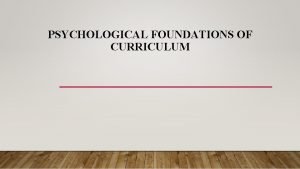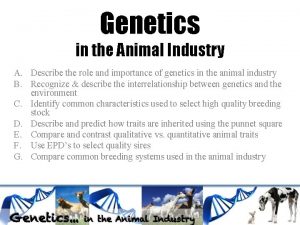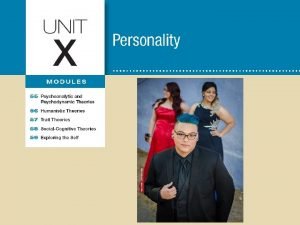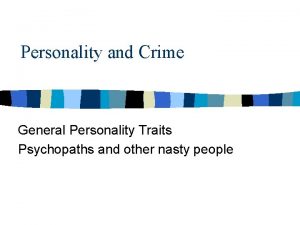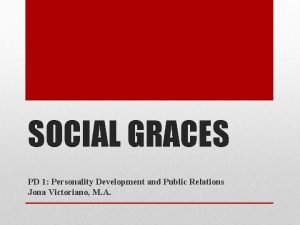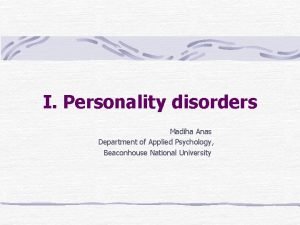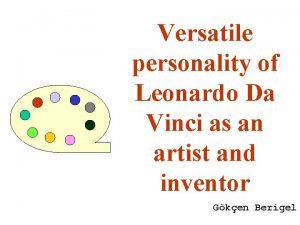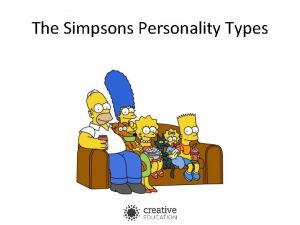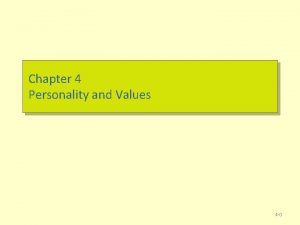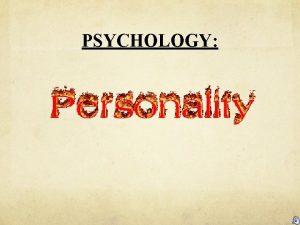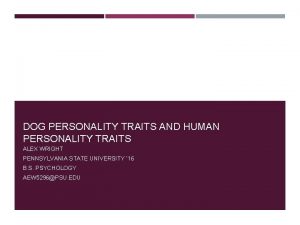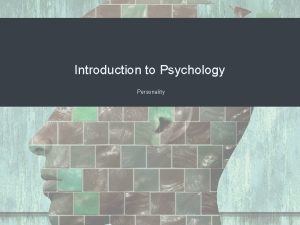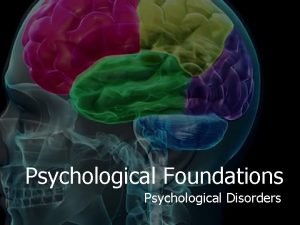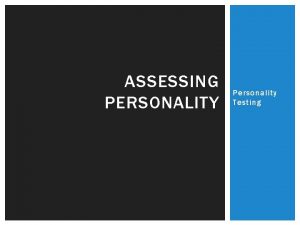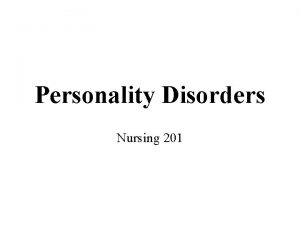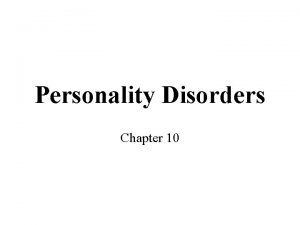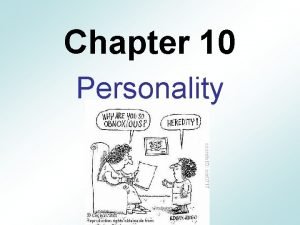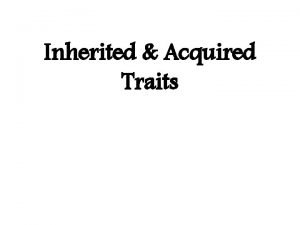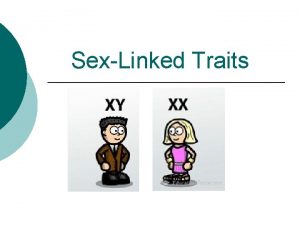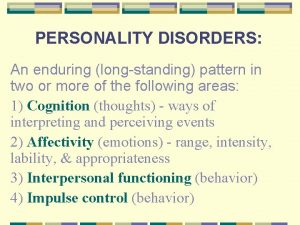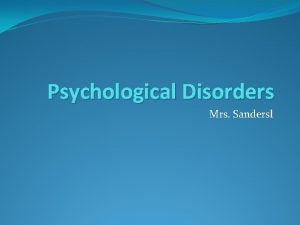Psychological Foundations Personality What is Personality Longstanding traits





























- Slides: 29

Psychological Foundations Personality

What is Personality? Long-standing traits and patterns that propel individuals to consistently think, feel, and behave in specific ways Kant’s adaptation of Galen’s four temperaments, arranged on two axes as suggested by Wundt (left)

Freudian Explanation of Personality develops from a conflict between two forces: our biological aggressive and pleasure-seeking drives versus our internal socialized control over these drives

Defense mechanisms: unconscious protective behaviors that reduce anxiety.

Freud’s Stages of Psychosexual Development Stage Age (years) Erogenous Major Zone Conflict Adult Fixation Example Oral 0– 1 Mouth Weaning off Smoking, breast or overeating bottle Anal 1– 3 Anus Toilet training Neatness, messiness Phallic 3– 6 Genitals Oedipus/Ele Vanity, ctra overambitio complex n Latency 6– 12 None Genital 12+ Genitals None

Inferiority Complex Proposed by Adler, it refers to a person’s feelings that they lack worth and don’t measure up to others’ or to society’s standard

Erikson’s Psychosocial Stages of Development Stage Age (years) Developmental Task Description 1 0– 1 Trust vs. mistrust Trust that basic needs, such as nourishment and affection, will be met 2 1– 3 Autonomy vs. shame/doubt Sense of independence develops 3 3– 6 Initiative vs. guilt Take initiative on some activities, may develop guilt if boundaries overstepped 4 7– 11 Industry vs. inferiority Develop self-confidence in abilities when competent or sense of inferiority 5 12– 18 Identity vs. confusion Develop identity and roles 6 19– 29 Intimacy vs. isolation Establish intimacy and relationships 7 30– 64 Generativity vs. stagnation Contribute to society and family 8 65– Integrity vs. despair Assess and make sense of life and meaning of contributions

Jung’s Ideas about Personality Collective unconscious: common psychological tendencies that have been passed down from one generation to the next Archetype: pattern that exists in our collective unconscious across cultures and societies

Introverts and Extroverts Introvert Extrovert Energized by being alone Energized by being with others Avoids attention Seeks attention Speaks slowly and softly Speaks quickly and loudly Thinks before speaking Thinks out loud Stays on one topic Jumps from topic to topic Prefers written communication Prefers verbal communication Pays attention easily Distractible Cautious Acts first, thinks later

Horney’s Coping Style Description Example Affiliation and dependence Child seeking positive attention and affection from parent; adult needing love Moving against people Aggression and manipulation Child fighting or bullying other children; adult who is abrasive and verbally hurtful, or who exploits others Moving away from people Detachment and isolation Child withdrawn from the world and isolated; adult loner Moving toward people

Learning Approaches to Personality Behaviorist Personality is shaped by reinforcements and consequences. Social-Cognitive Personality is developed through learning, which may be observational. People behave in a consistent manner based on prior learning. Both learning and cognition are sources of individual differences in personality. Reciprocal determinism Self-efficacy

Social-Cognitive Theory: Reciprocal Determinism Bandura proposed the idea of reciprocal determinism: Our behavior, cognitive processes, and situational context all influence each other.

Social-Cognitive Theory: Self-Efficacy Self-efficacy: someone’s level of confidence in their own abilities People with high self-efficacy believe that their goals are within reach, have a positive view of challenges, develop strong commitment to the activities in which they are involved, and quickly recover from setbacks

Social-Cognitive Theory: Locus of Control Locus of control refers to our beliefs about the power we have over our lives. It occurs on a continuum (below) from internal to external.

Mischel and the Person-Situation Debate • People are situation processors • They behave differently in different situations • A person’s behavior in one situation would likely be repeated in a similar one • Mischel studied self-regulation or will power in the marshmallow test

Humanistic Approaches: Maslow’s Hierarchy of Needs Maslow proposed that human beings have certain needs in common and that these needs must be met in a certain order The highest need is the need for self-actualization, which is the achievement of our fullest potential

Humanistic Approaches: Self Concept • Self-concept is illustrated below • When our ideal self is similar to the person we are, our real self, we experience congruence • Children raised with unconditional positive regard have the opportunity to self-actualize

Humanistic Approaches: The Good Life 1. A growing openness to experience 2. An increasingly existential lifestyle 3. Increasing organismic trust 4. Freedom of choice 5. Higher levels of creativity 6. Reliability and constructiveness 7. A rich full life

Biological Approaches: Heritability of Personality and Temperament Heritability refers to the proportion of difference among people that is attributed to genetics The Minnesota Twin Study found a 0. 50 or greater heritability ratio for personality traits including: leadership, obedience to authority, a sense of well-being, alienation, resistance to stress, and fearfulness Traits are determined by a combination of many genes, as well as by epigenetic factors that control whether the genes are expressed Most contemporary psychologists believe temperament has a biological basis due to its appearance very early in our lives • Reactivity refers to how we respond to new or challenging environmental stimuli • Self-regulation refers to our ability to control that response

Early Trait Theorists: Cattell • Traits are characteristic ways of behaving • 16 factors or dimensions of personality 1. 2. 3. 4. 5. 6. 7. 8. Warmth Reasoning Emotional Stability Dominance Liveliness Rule-consciousness Social boldness Sensitivity 9. Vigilance 10. Abstractedness 11. Privateness 12. Apprehension, 13. Openness to change 14. Self-reliance 15. Perfectionism 16. Tension

Early Trait Theorists: The Eysencks viewed people as having three specific personality dimensions: 1. Extroversion/introversion 2. Neuroticism/stability 3. Psychoticism/superego control

Trait Theory Today: The Five Factor Model

Culture and Personality The culture in which you live is one of the most important environmental factors that shapes your personality The term culture refers to all of the beliefs, customs, art, and traditions of a particular society. Three approaches to study personality in a cultural context: 1. Cultural-comparative approach 2. Indigenous approach 3. Combined approach

Regional Personality Clusters Suggest Cultural Influence

Tests of Personality Self-Report Inventories Projective Tests Minnesota Multiphasic Personality Inventory (MMPI): personality test composed of a series of true/false questions in order to establish a clinical profile of an individual Personality assessment in which a person responds to ambiguous stimuli, revealing hidden feelings, impulses, and desires • Rorschach Inkblot Test • Rotter Incomplete Sentence Blank (RISB) • Thematic Apperception Test (TAT) • TEMAS Multicultural Thematic Apperception Test and the Contemporized-Themes Concerning Blacks Test (C-TCB)

Practice Question What evidence suggests that culture plays a role in personality? What evidence suggests that genes play a role?

Quick Review • What are early theories about personality development? • What is the psychodynamic perspective on personality development, including the id, ego, and superego, defense mechanisms, and the psychosexual stages of personality development? • What are the contributions of Neo-Freudians to personality theory, including Adler’s inferiority complex, Erikson’s psychosocial stages, Jung’s ideas of the collective unconscious and archetypes, and Horney’s coping styles?

More Quick Review • What is the learning perspective on personality, including the concepts of reciprocal determinism, selfefficacy, locus of control, and the person-situation debate? • What are the contributions of humanists Abraham Maslow and Carl Rogers to personality development? • What are biological approaches to understanding personality, including the findings of the Minnesota Study of Twins Reared Apart, heritability, and temperament?

More Quick Review • What are the early trait theories of Cattell and Eysenck? • What are the Big Five factors? How do you categorize someone who is high and low on each of the five traits? • What are personality differences of people from collectivist and individualist cultures? What are the approaches to studying culture and personality? • What are different types of personality tests, including the Minnesota Multiphasic Personality Inventory and common projective tests?
 Humanistic conception of curriculum
Humanistic conception of curriculum Dynamics of personality examples
Dynamics of personality examples Qualitative traits vs quantitative traits
Qualitative traits vs quantitative traits Qualitative traits vs quantitative traits
Qualitative traits vs quantitative traits Qualitative traits vs quantitative traits
Qualitative traits vs quantitative traits Steve randles personality
Steve randles personality Literary foil
Literary foil Definition of personality
Definition of personality What personality traits do electricians have
What personality traits do electricians have Personality.traits
Personality.traits Psychopath causes
Psychopath causes What is social graces
What is social graces Confident personality traits
Confident personality traits Character traits for romeo
Character traits for romeo Sacrifice character trait
Sacrifice character trait What hue are you
What hue are you Personality trait definition
Personality trait definition Whats up do
Whats up do Examples of ego defense mechanisms
Examples of ego defense mechanisms Avoidant personality traits
Avoidant personality traits Leonardo da vinci personality
Leonardo da vinci personality Infj simpsons character
Infj simpsons character The outsiders character list
The outsiders character list Personality traits of friar lawrence
Personality traits of friar lawrence Cronus personality traits
Cronus personality traits Big five personality traits
Big five personality traits John hale quotes
John hale quotes Dogmatism in consumer behaviour
Dogmatism in consumer behaviour Dramatic personality disorders
Dramatic personality disorders Kurt cobain personality traits
Kurt cobain personality traits
